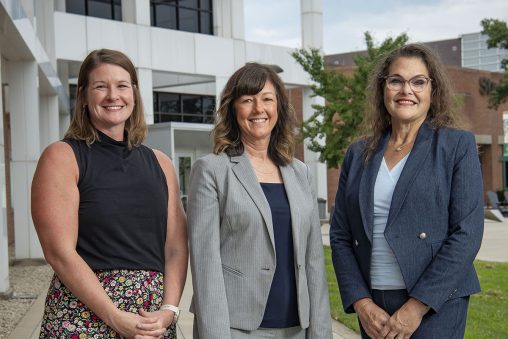
From left: Nicole Kinzeler, assistant professor in the Department of Population and Public Health Sciences; Barb Marsh, director of Counseling and Wellness Services; and Jennifer Hughes, chair of the Department of Social Work and interim chair of the Department of Human Services, will lead a federally funded project to provide mental health services children, adolescents and young adults in rural and medically underserved areas. (Photo by Erin Pence)
Graduate students in Wright State University’s social work and counseling programs will help address the growing demand for mental health services in underserved communities through a new initiative aimed at expanding the region’s behavioral health workforce.
Funded by a four-year $2.4 million grant from the Health Resources and Services Administration, Wright State’s Workforce Wellbeing Initiative will place students in clinical internships serving children, adolescents and young adults in rural and medically underserved areas.
Developed by Wright State’s College of Health, Education and Human Services in partnership with Counseling and Wellness Services, the initiative responds to critical provider shortages and mental health disparities across Ohio.
“The purpose of the program is to increase the number of professionally trained behavioral health providers in the Greater Dayton area,” said Barb Marsh, D.S.W., director of Counseling and Wellness Services at Wright State. “We will achieve this goal by expanding on-site internships for students in our behavioral health degree programs. This initiative will increase access to behavioral health services in currently underserved communities.”
Marsh, who has more than 25 years of experience in mental health, substance use disorder, and public health, led the grant application submission. The principal investigator, Jennifer Hughes, Ph.D., is a professor and chair of the Department of Social Work and interim chair of the Department of Human Services. Nicole Kinzeler, Ph.D., assistant professor in the Department of Population and Public Health Sciences and assistant director of the Substance Abuse Resources and Disability Issues Program in the Boonshoft School of Medicine, will serve as the lead evaluator for the grant.
The initiative builds on Wright State’s long-standing relationships with regional behavioral health providers. The university is collaborating with partner agencies to support the grant and student placements: the Greater Dayton Area Hospital Association, Dayton Children’s Hospital, Five Rivers Health Centers, Kettering Behavioral Health and Rocking Horse Community Health Center.
“The partnerships formed as a result of intentional collaboration across academic, clinical and community sectors,” Hughes said. “These partnerships were designed to strengthen workforce development pipelines and ensure that students and trainees are prepared to meet the behavioral health needs of underserved populations.”
Partner organizations were selected based on their ability to offer high-quality, diverse clinical training sites while also benefiting from increased workforce support and the opportunity to shape the next generation of providers.
Starting in fall 2025, Wright State will place 12 master’s-level interns with partner organizations each year for four years.
“These opportunities will allow our students to complete their degrees while gaining meaningful, real-world experience with our community partners,” Hughes said. “By providing these essential supports, we are equipping students to succeed academically, grow in confidence and pursue impactful careers serving high-need populations after graduation.”
The need for mental health services in Ohio is urgent. The state currently meets just 30% of its mental health care needs based on population, making it one of the states with the highest provider shortages, according to Kinzeler.
In 2022, fewer than 70% of mental health clients in Ohio received treatment within 14 days of their initial assessment. The same year, Ohio recorded higher-than-average rates of suicide, youth suicide and unintentional drug overdose, all of which increased compared to the previous year.
Kinzeler cited multiple drivers of this growing demand, including high drug overdose death rates, substance use and the lingering effects of grief and isolation from the COVID-19 pandemic.
The crisis is particularly severe among youth. In a 2021 survey, nearly 43% of Ohio high school students, including more than 56% of girls, reported feeling persistently sad or hopeless for two or more weeks in a row. One in five students has seriously considered attempting suicide, and 15.4% of high school girls reported attempting it at least once. Despite this, more than half of Ohio youth with depression did not receive care in the past year.
“That’s concerning for a number of reasons, but especially because high school students with depression are more than twice as likely to drop out of school than their peers, and this increases their likelihood of having encounters with law enforcement,” said Marsh. “Seven in 10 youth in the juvenile justice system have a mental health condition, but few are receiving treatment.”
While the current grant cycle runs through June 2029, Wright State and its partners are already exploring federal, state and local funding opportunities to continue the program after the initial funding ends.

 Milling around
Milling around  Wright State recognizes Nursing Professor Kim Ringo for advancing international student success
Wright State recognizes Nursing Professor Kim Ringo for advancing international student success  Wright State honors graduating students for distinguished doctoral dissertations
Wright State honors graduating students for distinguished doctoral dissertations  Top 10 Newsroom videos of 2025
Top 10 Newsroom videos of 2025  Museum-quality replica of historic Hawthorn Hill donated to Wright State
Museum-quality replica of historic Hawthorn Hill donated to Wright State 